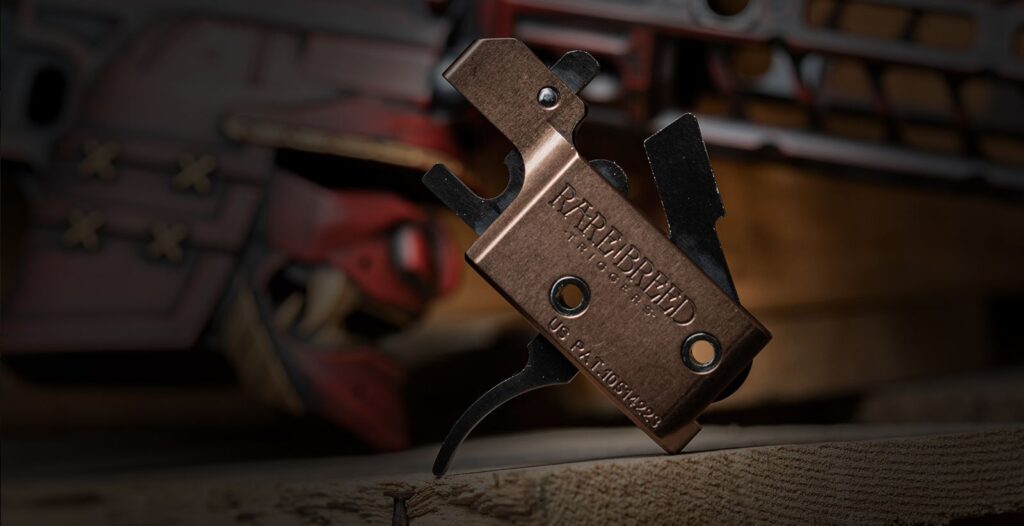The Forced Reset Trigger (FRT) has fundamentally revolutionized firearm technology, pushing the boundaries of shooting efficiency while maintaining safety and compliance. This advanced trigger mechanism, designed to reset itself automatically after each shot, has gained widespread attention from firearm enthusiasts, competitive shooters, law enforcement, and hunters. The FRT trigger’s ability to optimize firing rates, reduce manual effort, and improve precision makes it a game-changer in modern firearm customization.
But what distinguishes a Forced Reset Trigger from other types, such as standard or binary triggers? How does it work, and why has its innovation sparked debate, even as it gained popularity? This comprehensive guide will explore the mechanics, benefits, and legalities of FRT triggers while comparing them to other options. Whether you’re a seasoned shooter or new to firearm modifications, this guide covers everything you need to know.
What Does FRT Stand For?
FRT stands for Forced Reset Trigger. This technology enhances semi-automatic firearms by using mechanical force to reset the trigger after each shot. Unlike conventional triggers that require the shooter to manually release the trigger, the FRT enables rapid firing by automating this process.
Key Features of an FRT Trigger:
- Rapid Reset Mechanism: Reduces the time between shots, enabling faster firing cycles.
- Mechanical Consistency: Ensures a precise reset after each pull, enhancing shooting accuracy.
- Semi-Automatic Compliance: Designed to operate within legal regulations for semi-automatic firearms.
- Durable Build: Constructed with high-quality materials to withstand intensive use.
Why Forced Reset Technology is Transformative
Traditionally, shooters using semi-automatic guns were limited by the time and effort required to reset the trigger manually. The Forced Reset Trigger solves this issue by automating the process, allowing shooters to focus more on their aim and less on mechanics. Whether it’s for target practice, hunting, or competition, this efficiency gives users an edge.
How Does an FRT Trigger Work?
At its core, the Forced Reset Trigger uses the firearm’s internal mechanics to reset the trigger automatically after a shot is fired. This system relies on the motion of the bolt carrier group (BCG) to generate the force needed for reset. By automating this process, the FRT ensures that the firearm is ready for the next shot almost instantly.
Step-by-Step Breakdown of FRT Technology:
- Trigger Pull: The shooter initiates the process by pulling the trigger, firing a round downrange.
- Bolt Carrier Group Movement: As the fired round exits, the BCG cycles, creating mechanical energy.
- Spring-Loaded Reset: This mechanical energy forces the trigger back to its reset position.
- Next Round Readiness: The firearm is now ready for the next shot without manual intervention.
This seamless process speeds up firing rates while maintaining user control. By eliminating the lag associated with manual resets, the FRT outperforms traditional triggers in terms of both speed and precision.

The Role of the Bolt Carrier Group
The Bolt Carrier Group not only cycles rounds through the chamber but also fuels the FRT mechanism. Whether using a direct-impingement or gas-piston operating system, the BCG is essential for channeling the energy needed to automate the trigger reset.
Advantages of Forced Reset Triggers
- Faster Tactical Response: Respond quickly in competitive or defensive situations.
- Improved Accuracy: Enhanced consistency during high-speed shooting reduces shot deviation.
- Lesser Manual Effort: Suitable for prolonged use without experiencing fatigue.
FRT Trigger Meaning in Modern Firearms
The FRT trigger is more than just a mechanical upgrade—it symbolizes how firearm technology is evolving to meet modern needs. Whether you prioritize precision, safety, or functionality, the FRT trigger embodies innovation in firearm customization.
Why Enthusiasts Choose Forced Reset Triggers
- Competitive Advantage: Shooters in competitions gain an edge with faster firing rates.
- Dynamic Target Engagement: Responding to moving or multiple targets becomes easier with automatic resets.
- User-Friendly Operation: The system is easy to master, even for novice users, thanks to its intuitive design.
The ability to access advanced firing capabilities without stepping outside the legal framework is a key reason FRT triggers are increasingly sought after. For owners of AR-15-style rifles and other compatible platforms, the FRT bridge the gap between standard operations and high-performance shooting.
How FRT Triggers Compare to Standard Triggers
One of the common questions among firearm enthusiasts is how FRT triggers stack against traditional stock triggers. Standard triggers depend entirely on the shooter’s manual input for every pull and reset cycle, limiting their speed and efficiency, especially during rapid-fire scenarios.
Key Differences:
| Feature | Standard Trigger | Forced Reset Trigger |
| Mechanism | Manual reset required | Automated reset via mechanics |
| Firing Rate | Slower due to manual cycle | Faster, thanks to instant reset |
| User Fatigue | Higher for extended sessions | Lower due to reduced effort |
| Ease of Use | Basic | Intuitive, even for beginners |
| Compatibility | General-purpose use | Designed for competitive and tactical scenarios |
FRT triggers dramatically increase performance, making them an excellent upgrade for those seeking higher fire rates in semi-automatic firearms.
FRT Trigger vs. Binary Trigger
While FRT triggers improve firing efficiency, some shooters also explore binary triggers, which function differently. A binary trigger initiates one shot upon pulling the trigger and another upon releasing it, effectively doubling the firing cycle with each trigger movement.
Comparative Analysis:
| Feature | FRT Trigger | Binary Trigger |
| Action Type | Fires once per trigger pull | Fires on both pull and release |
| Operational Precision | Easier to control and master | Requires practice to avoid accidental discharge |
| Safety Considerations | Lower risk of unintentional firing | Greater risk, especially for beginners |
| Recommended Use | Tactical, recreational, and competitive | Niche applications, such as specialist competitions |
While binary triggers boast a unique method of operation, FRT triggers are favored for their simplicity and practicality.
Legal Considerations for FRT Triggers
The legality of FRT triggers has led to ongoing discussions among firearm regulators, especially from organizations like the Bureau of Alcohol, Tobacco, Firearms, and Explosives (ATF). While FRT triggers are classified as semi-automatic components under the National Firearms Act (NFA), their advanced functionality may provoke scrutiny.
Points to Consider:
- Federal Regulations: FRTs comply with NFA regulations as they fire only one round per pull.
- State Laws: Some states impose stricter rules or outright bans on aftermarket trigger modifications.
- Local Authority Guidance: It’s advisable to consult local laws and legal counsel if you plan to purchase or install an FRT trigger.
States with Restrictive Laws
- California
- New York
- New Jersey
- Massachusetts
Ensuring compliance with local laws is critical. Always stay updated on legislative changes related to firearm accessories like the Forced Reset Trigger.

Benefits of an FRT Trigger
The benefits of installing an FRT trigger extend beyond speed. Its unique design improves multiple aspects of the shooting experience.
Performance Benefits:
- Enhanced Precision: Mechanical resets produce decisive follow-up shots with minimal delay.
- Ease of Use: Intuitive for shooters of all skill levels.
- Durability: Dependable performance even under heavy use, thanks to robust construction.
Applications:
- Competitive Shooting: Gain a significant advantage during high-stakes matches.
- Hunting: Deliver quick, successive shots for effective target engagement.
- Home Defense: Optimized for rapid response while maintaining control.
Maintaining Your Forced Reset Trigger
Proper maintenance is essential to keep your FRT trigger performing at its peak.
Maintenance Tips:
- Regular Cleaning: Prevent residue buildup that could impede mechanics.
- Lubrication: Use approved lubricants to keep the system running smoothly.
- Bolt Carrier Check: Ensure that your bolt carrier group remains well-maintained for efficient cycling.
Exploring our customization services ensures that features such as bolt carriers, barrels, or safety levers align perfectly with your FRT setup.
Additional Firearm Customization Options
Enhancing your firearm experience doesn’t stop at adding a Forced Reset Trigger. Our range of customization services allows you to fully optimize your firearm with premium upgrades.
Available Services:
- Ergonomic Safety Levers: Improve control and accessibility.
- Enhanced Optics: Add precision with high-quality scopes.
- Custom Barrels: Upgrade for advanced accuracy.
For more information about these services, visit our Website.
FAQs About Forced Reset Triggers
Q: Are FRT triggers legal in the United States?
A: Yes, but legality may vary at the state level. Always consult local laws before purchasing.
Q: Can FRT triggers damage my firearm?
A: No, they’re designed to work seamlessly with specific platforms like the AR-15. Pairing with a suitable Bolt Carrier Group ensures compatibility.
Q: Do Forced Reset Triggers work with all semi-automatic firearms?
A: While primarily designed for AR-15 rifles, some FRT variants also support other platforms. Check compatibility with your firearm.
By understanding “What is an FRT Trigger?” you can make an informed decision about its suitability for your needs. Whether maximizing firing rates, improving accuracy, or exploring cutting-edge firearm upgrades, the Forced Reset Trigger remains one of the most impactful innovations shaping firearm performance today. This guide ensures you’re equipped with the knowledge to take full advantage of its potential.


